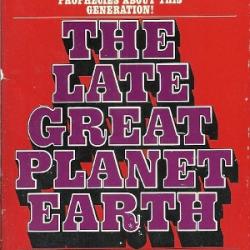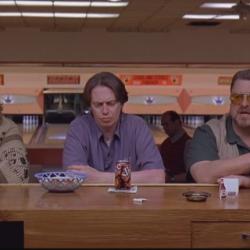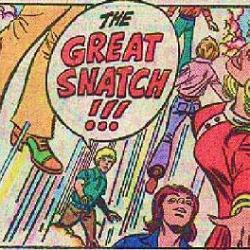Left Behind II: Tribulation Force, Part 4
Rayford Steele delivers his speech and Chris Smith delivers the gun.
Let’s set aside the content of Rayford’s speech — more or less, “magnets, how do they work? Therefore, God” — and just consider the fact of it and the result of it. This is a major difference between the movies and the books. In the books, Smith, Rayford’s co-pilot, kills himself. Book-Rayford barely notices, and then never gives his long-time colleague another thought. Here in the movies, though, Chris telephones Rayford for help and Rayford offers that help.
So here in the movies, unlike in the books, Chris is still alive.
That highlights the vast difference between book-Rayford, as written by Tim LaHaye and Jerry Jenkins, and movie-Rayford, as portrayed by Brad Johnson. If book-Chris had thought of making a desperate final phone call, it wouldn’t have been to book-Rayford, because he would never have come to help. Movie-Chris made that phone call because he knew that movie-Rayford would come. That’s a big change, not just for Chris, but for the reader/viewer.
Back at the church, everybody’s gone. Bruce Barnes delivered his big altar call less than an hour ago, but all those people who came forward — brand-new believers full of questions and in need of guidance — were apparently quickly shooed away so that Bruce, Chloe and Buck could have an inner-circle Tribulation Force meeting.
Cam-Cam is worked up over the Two Witnesses story, announcing what he regards as an innovative and ingeniously sneaky plan. He’s a TV reporter — he could report on the witnesses on TV! Bruce agrees this is deviously brilliant.
Rayford arrives and we come to another welcome change in the story. Tribulation Force, the novel, bogged down for hundreds of pages in the middle with Rayford and Buck insisting for several chapters that they would never, ever, under any circumstances accept a job working for Nicolae Carpathia, each turning away from the jobs being thrust at them from every side. (“Bogged down” is a relative term. It’s not as though this detracted from the otherwise fast-paced action of the plot — which was meandering and uneventful before and after this interlude. But that part of the book seemed even slower and more pointless than the sluggish, meaningless padding that surrounded it.)
Here in the movie, Rayford and Buck already seem to have made up their minds — both committing to seek out jobs that will bring them closer to Nicolae. This change spares us all the ploddingly dull treading water in the novel, while also making our heroes active characters who make their own decisions.
Unfortunately, the filmmakers choose to emphasize this decisiveness by reversing Chloe’s role in all of this. In the book, she encouraged her father and her sort-of-boyfriend to risk the danger of proximity to Nicolae in service of the goals of the Tribulation Force (although those goals were never explained, much less realized). But here her role is to protest that this danger is too great. “Whatever!” she says, storming out with the same petulance she’s shown in every scene of this film so far.
This is disappointing, a step backwards from the more capable and independent-minded Chloe we met in the first book and the first movie. The first Left Behind novel spent several chapters tracing Buck’s efforts to travel from Chicago to New York in the aftermath of the Event, yet Chloe managed to travel even further — from San Jose to Chicago — without any of the connections or financial resources Buck had at his disposal. She’s also the only person in that book with enough clarity and gumption to question Bruce’s pat, simplistic explanation of the calamity they’re all experiencing. But so far in this movie, she’s mostly been just a whiny brat.
And that seems deliberate. The earlier scene in the church-based emergency shelter seemed to have been included just to show us that Chloe is useless in a crisis. I wouldn’t have thought it possible, but the filmmakers’ treatment of female characters may be even worse than the madonna-whore abominations of the books. For the first half of this movie, Chloe exists only to serve as a foil — a weak character used to make Rayford and Buck seem stronger.
The odd result of that is that I’m having a mixed reaction to Chloe in this movie. She’s utterly unlikeable, but her being so utterly unlikeable is so clearly a product of the filmmakers’ dislike for women in general that my dislike for the character is tinged with sympathy and even a sense that I feel an urge to take her side against them. That’s a weirdly multi-layered response to a one-note performance and a two-dimensional character.
The following day, we see a smallish plane at a desolate-looking regional airstrip and it takes a moment to realize this is the much-ballyhooed Global Community One that plays such a central role in the book. (I’m not an airplane expert, but this doesn’t look anything like the ginormous plane described in the book.)
The dynamic between Rayford and Hattie here is the opposite of that in the book. There she spends several chapters clumsily trying to manipulate him into coming to work for Nicolae. Here he is the supplicant who comes to her, pleading for her help. Chelsea Noble — Mrs. Kirk Cameron — is passable in this scene as Hattie enjoys the chance to make Rayford sweat a bit. I don’t think we’re supposed to enjoy that with her — I think we’re supposed to view her as deceived and villainous. But she’s not wrong.
Rayford’s responses here recall some of the casuistry in the books. The authors repeatedly — if inconsistently — stress that it is never permissible to tell a lie, not even to the Antichrist. Yet the authors also hold that one can intend to deceive another as long as some meaning of the words being spoken are in some sense technically true. In that case, they say, it’s not a lie. In this scene, Rayford is trying to be hired as Nicolae’s pilot in order to serve as a spy, yet despite this intrinsically deceptive agenda, the filmmakers take care not to have Rayford speak any words that aren’t at least technically true.
Hattie’s biggest objection to considering Rayford for this job is that he is aligned with “the Bible-thumpers” who, she says, are spreading rumors that Nicolae is, “What is it? Oh, yes, ‘the Antichrist.'”
She seems unfamiliar with that term and that concept — as though it weren’t a centuries-old epithet and a common trope in popular culture and entertainment.
The story requires this. For this story to play out the way it does, it’s necessary that Hattie and nearly everyone else on Earth has never heard the word “Antichrist.” Thus the world of this story is a world in which no one ever saw movies like The Omen. It’s a world in which Hal Lindsay’s The Late Great Planet Earth was not the best-selling book of the 1970s,. It’s a world in which “Bible prophecy” experts haven’t spent decades warning that John F. Kennedy, Nikita Kruschev, Pope Paul VI, Lyndon B. Johnson, Leonid Brezhnev, Richard Nixon, Gerald Ford, John Paul I, John Paul II, Jimmy Carter, Ruhollah Khomeini, Ronald Reagan, Yuri Andropov, Moammar Gadhafi, Prince Charles, Konstantin Chernenko, Mikhail Gorbachev, George H.W. Bush, Saddam Hussein, Bill Clinton and Bill Gates each might be the Antichrist.
Something like this is true of many stories that include famous figures from popular culture. Consider, for example, Star Trek IV. In that movie, Capt. Kirk, Spock, McCoy and Scottie travel back in time and wind up in San Francisco in 1986. This setting was meant to be realistic — to be just like the actual San Francisco of 1986. But the story required one big difference from the actual, real-world city — in the story’s version of the city, no San Franciscan had ever heard of James T. Kirk or Mr. Spock or the Starship Enterprise.
That’s not an insurmountable problem when the story in question is just an enjoyable diversion like those even-numbered Star Trek movies, but it’s a much bigger hurdle for this story, because this story purports to be more than that. This story claims to be a prophecy — a portrayal of future events that the storytellers insist will occur and must occur very soon. That claim of prophecy — of being a true story that hasn’t happened yet — is part of what accounts for the runaway popularity of the Left Behind books. Unfortunately, that very popularity — the existence in print of tens of millions of these books — is a fact incompatible with this story. This story cannot occur here in the real world because here in the real world we’ve seen The Omen and we’ve read Hal Lindsey, and now we’ve read this story too.
Chloe drops by Bruce’s office for the awkward “relationships in the End Times” conversation. This scene is blessedly much shorter than the one in the book, with Bruce offering at least one very practical piece of advice: “You ought to talk to him.”
That brings us to the movie’s version of the book’s Not What It Looks Like romantic mix-up. This involves Chloe putting on her best dress before knocking on the door to Buck’s apartment. She’s met there by Ivy Gold, who answers the door in a blue bathrobe and mistakes Chloe for a cable-news groupie. (Is that really a thing? I’m guessing Chris Matthews would say, “No, that never really happens” while Anderson Cooper might have a different take.) Ivy, remembering Cam-Cam’s “don’t let anyone in” instructions, curtly waves Chloe away, flashing her prominent engagement ring.
Nightfall finds Chloe at home, disappointed, heart-broken and wearing what appears to be Ivy’s bathrobe. Cam-Cam calls her on the phone and she hangs up on him.
After the whole NWILL mix-up, Chloe is now reacting to everything Buck does with a petulant hostility. This is a conventional plot device in romantic comedy, but I’m not sure it works here since, even before the mixup Chloe was reacting to everything Buck did with an indistinguishable petulant hostility.












